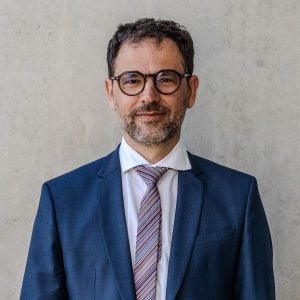
Rare earths are critical, but Europe has almost none of its own. Long overlooked, they have become the missing piece in Europe’s clean tech puzzle. In the global tug of war over rare earth elements (REE), Europe has been playing catch-up – until now.
In south-west France, start-up Carester is building what could become one of Europe’s first operational rare earth production facilities. The €216m ($245.31m) Caremag project aims to supply 15% of the global market for heavy rare earths by combining recycled materials and imported concentrates to create a homegrown refining capability.

Discover B2B Marketing That Performs
Combine business intelligence and editorial excellence to reach engaged professionals across 36 leading media platforms.
“Carester is a company I founded in February 2019 with five rare earth refining experts. We had all been working independently for mines around the world. At some point, we decided to join forces, bring in younger talent and pass on this unique know-how,” said Carester president Frédéric Carencotte in an interview with Mining Technology.
The goal was twofold: “to preserve that expertise” and “to pair it with a real industrial project. I wanted to give it an industrial footprint. That is the foundation of Carester,” he explained.
Turning waste into REE supply
The Carester team saw untapped potential in end-of-life equipment and chose to base their project on recycling. With no active rare earth mines available in France or Europe in the short term, and with prior experience in recycling, the approach offered both strategic relevance and technical feasibility.
“We realised we had a resource right in front of us – all this end-of-life equipment. So we decided to launch our own industrial project, based on recycling,” Carencotte explained.

US Tariffs are shifting - will you react or anticipate?
Don’t let policy changes catch you off guard. Stay proactive with real-time data and expert analysis.
By GlobalDataCarester announced in March 2025 that its subsidiary and industrial arm Caremag SAS had secured €216m to build a rare earth recycling and refining facility in Lacq, in south-west France. Expected to be operational by late 2026, the site is set to become Europe’s first large-scale industrial plant dedicated to rare earth separation.
The facility will process 2,000 tonnes per annum (tpa) of end-of-life magnets and 5,000tpa of mined concentrates. A typical magnet contains around 30% rare earths, some boron, and the rest is iron.
Caremag plans to recover more than 95% of the rare earths and boron, converting the latter into pure boron or borax. The iron, for now, is being treated as standard waste and buried, although the company is exploring ways to recover and reuse it within four to five years.
Once running at full capacity, the Caremag facility is expected to produce 600tpa of dysprosium and terbium oxides – roughly 15% of world supply — along with 800tpa of neodymium and praseodymium oxides, key materials in permanent magnets used in electric vehicles, wind turbines and electronics.
Carencotte believes that “from the start, the real challenge was properly sizing the project” as “it had to be impactful for [their] clients, viable in terms of funding and backed by secure sources of supply”.
To reach that scale, Carester “made a strategic choice: not to limit [itself] to recycling”.
“Our base is recycled material, but we have added a mining component,” Carencotte told Mining Technology, underlining that this combination of recycled feedstock and mined concentrates, especially for heavy rare earths, allows the company to aim for 15% of the global market.
Caremag secures backing from Japan and France
The Caremag project’s €216m funding package includes €110m (Y17.96bn) from Japanese investors, notably the Japan Organisation for Metals and Energy Security and Iwatani, through a joint venture called the Japan France Rare Earth Company. The deal also involves a long-term supply agreement to provide heavy rare earth oxides to Japan.
Public funding from the French Government totals €106m, through a mix of grants, repayable advances (via France Relance and France 2030) and a green industry tax credit. Additional support came from the Nouvelle-Aquitaine region, TotalEnergies (via its Induslacq site) and equity contributions from Carester and its employees, 21 of whom are shareholders in Caremag.

“Europe has also supported us significantly. The Critical Raw Materials Act, through its directives and especially its targets, gave us a clear direction,” said Carencotte. “It gave credibility to the idea of producing in Europe. It created a clear framework – and that changed everything.”
Caremag was named one of the 47 strategic projects selected by the European Commission on 25 March 2025 to help secure and diversify the EU’s access to critical raw materials.
The Lacq facility will produce both light and heavy REEs. Around 90% of the light rare earths will come from recycled sources, mostly within Europe. In contrast, 90% of the heavy rare earths will be sourced from mining operations, primarily outside of Europe. Approximately half of the heavy rare earth output will be shipped to Japan and its industrial partners.
“The recycling sources are mostly European, with a significant portion coming from France,” Carencotte noted, while “the mining sources will be exclusively non-European, at least for the first few years”.
“That said, we are already working on a few projects to secure some mining supply from within Europe in the longer term,” he added.
Strategic deals with Stellantis and Solvay
In September 2024, Carester signed a ten-year commercial agreement with automotive giant Stellantis for the supply of more than 3,400t of neodymium, praseodymium, dysprosium and terbium oxides, 36% of which will come from recycled materials. The deal secures a key long-term customer for the Lacq facility.
Earlier in March 2024, Carester also signed a memorandum of understanding with Belgian chemical group Solvay to explore a strategic partnership focused on rare earth separation and circular value chains in Europe. The collaboration aims to combine Carester’s refining expertise with Solvay’s industrial capabilities to strengthen Europe’s rare earth supply independence.
Caremag’s low-carbon design
The Caremag plant will operate a continuous, closed-loop process designed for uninterrupted production. It begins with pyrometallurgy to treat the magnets, followed by hydrometallurgy and liquid-liquid extraction to purify and separate the rare earths. From raw input to final output, the process takes several weeks, reflecting its complexity and the plant’s focus on stability.
The site was also engineered with environmental performance in mind. It runs entirely on electricity (no gas), relying solely on low-carbon power from the French grid. Water use is tightly controlled: the industrial building is expected to consume less water than the administrative offices. A 250m³ on-site water buffer will help balance usage across seasonal variations.
Some water will be recovered directly from incoming materials as recycled magnets and scrap often contain residual liquids. Most of the rare earths will arrive in carbonate form, ready for processing.
“We are not trying to invent new technology just for the sake of it,” said Carencotte. “We develop useful, practical technology that improves the efficiency of our process. It is technology built to optimise operating costs.”
China dominates in REE, Europe lags behind
China dominates the global REE market, accounting for 69% of production and nearly 90% of global processing capacity as of 2023, as reported by GlobalData in its Global Rare Earths Mining Review 2025, released in January.
As of January 2024, global rare earth reserves were estimated at 110 million tonnes, according to the US Geological Survey. While global reserves are spread across China, Vietnam, Brazil, Russia and India, China’s lead in both mining and refining is unmatched. The US holds a 12.3% production share, with Australia emerging as another rising player.
Europe, by contrast, has had no operational REE refining capacity since the 1990s, a gap that Caremag seeks to close as pressure mounts to localise supply chains for clean technologies.
Carencotte, who views permanent magnets as the core driver of rare earth demand, remains confident in the long-term outlook: “The long-term trend hasn’t changed: we are moving towards an electrified world,” he says, viewing short-term fluctuations as noise in an otherwise clear trajectory.
“I am convinced the need for rare earths, especially for permanent magnets, is going to keep growing. It is a fast-expanding application, and that momentum will continue,” he concluded.





